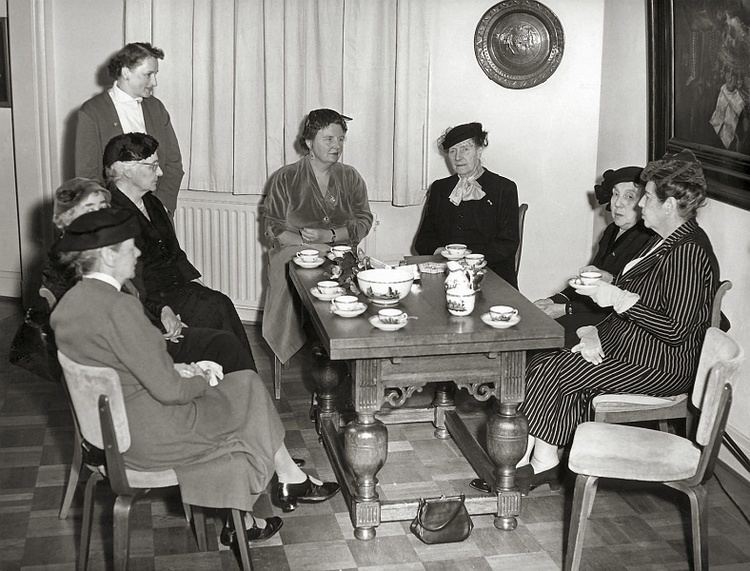 | ||
De amsterdamse joffers
The Amsterdamse Joffers was a group of women artists in Amsterdam who met weekly in the last quarter of the 19th century to paint and show their works together. They were known for their style that followed the example of the Amsterdam Impressionists, and were all members of the Amsterdam artist societies Arti et Amicitiae and Sint Lucas, and most followed the lessons by professor August Allebé of the Rijksakademie van beeldende kunsten of Amsterdam.
Contents
- De amsterdamse joffers
- History
- Style and work
- Prizes and exhibitions
- International comparison
- Members of the circle
- They are not closely acquainted
- Some selected works
- Museum Guide of the Amsterdamse Joffers
- Exhibitions
- References
History
In the late 19th century and early 20th century in Amsterdam a group of young women had come together to found a circle. Their goal was to pursue painting as a form of art. They came from wealthy families, and were therefore not forced to fight their livelihoods. They had almost all the visited the Rijksakademie van beeldende kunsten of Amsterdam. One exception was Sue Robertson, who had visited the Polytechnic in Delft and received private drawing lessons. Lizzy Ansingh had received private lessons in addition to the lessons with August Allebé, Nicolaas van der Waay and Carel Dake. Nelly Bodenheim was an illustrator and was thus not a painter in the sense of this art movement more. Coba Ritsema initially received her education in the Haarlem he School of Art and than at the Rijksakademie van beeldende kunsten Amsterdam - there she was in a women's group. - Here she was taught from August Allebé, Nicolaas van der Waay and Carel Dake, too. She received from Thérèse Schwartze, Jacob Ritsema (her brother), Carel Lodewijk Dake, George Hendrik Breitner and Fredik Theodorus Grabjin secondary education. Some of her students were Coba Suri, Jan van den Hengst, Tine Honey, Victoire Winix and Lize Duyvis.
This group was made up to a circle. They had weekly a meeting in the house of Thérèse Schwartze. Subject was the exchange of experiences from her work as an artist.
Sue Robertson, Jacoba Surie, Johanna Elisabeth Westendorp-Osieck and Coba Ritsema were members of Arti et Amicitiae and Pulchri Studio.
In 1912, this movement received the name Amsterdamse Joffers by an art critic of Albert Plasschaet . This word was used in a newspaper article.
Style and work
Art historically, the Amsterdamse Joffers are assigned to the Impressionists and the era of Dutch Late Impressionism. In her paintings dominated still life and portraiture. On a little scale they had also adopted the genre.
Prizes and exhibitions
In 1910 Coba Ritsema won the bronze medal at the international exhibition in Brussels. Between 1912 and 1923 she won the silver medal of the city of Amsterdam, and in 1918 the Royal Medal was presented to her by the Queen Wilhelmina.
In 1906 Lizzy Ansingh and in 1910 Elsa van Doesburg hat won the Willink van Collenprijs of the art association Arti et Amicitiae Amsterdam.
International comparison
If one looks to France, the country of origin of impressionism, there are four women painters. These are Marie Bracquemond (1840-1916), Mary Cassatt (1845-1926), Eva Gonzalès (1847-1893) and Berthe Morisot (1841-1895). Art Historically, they count on the core of the French movement. Characteristic of her paintings is the powerful, light-filled color palette with lively motifs. This is rounded off with the typical for the impressionism lighting.
When comparing these four women painters with the female flow of Dutch Impressionism, there are a number of points. The Dutch women lived later, so they may have taken the work of the French women only as a model. The Dutch color palette is more representative of the severity of the darker colours of the 1st generation and some of the more vivid palette of the 2nd generation of the Hague School. Here is the quiet and melancholy, which emanates from the chosen darker colours. The French women had chosen the genre, the landscape painting (coastal, harbor and countryside with views of the city), still life and the portrait. The Dutch women on the other hand choose almost exclusively the still life and the portrait. The still life of frenchwomen is marked by an ease. The Dutch women do not equal, there is a dark, oppressive melancholy in the painting.
These paintings by international standards - here with France - are also the best example of the unique mentality of the countries and the influence in their painting. This is an essential feature of the art movement of impressionism, too.
